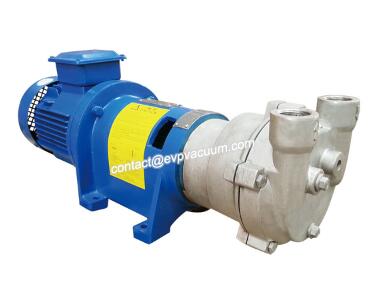Minimum capacity vacuum pump
Depending on the type and manufacturer of the vacuum pump, the capacity of the vacuum pump can be specified in two different ways. It is important to know the ACFM rating of the vacuum pump, which represents the “actual cubic foot per minute” inlet capacity at a specific vacuum level. Also know what the minimum capacity vacuum pump value is.
Liquid ring vacuum pumps are rated according to ACFM, and the actual capacity under different vacuum degrees is shown in the performance curve of each pump.
The capacity expressed in CFM or scfm (standard cubic feet per minute) can be misleading because we have to consider the volumetric efficiency of the pump at a particular vacuum (see example below). The rated free air displacement of the vane pump is usually CFM, which is the theoretical displacement under 0 “Hg vacuum.
Manufacturers of small rotary vane vacuum pumps rate their pumps in scfm at different vacuum levels.
The piston vacuum pump is rated by the theoretical displacement in the CFM, known as the piston displacement (PD).
In order to be able to compare the capacity of different vacuum pumps, we need to calculate the actual capacity (ACFM) under different vacuum degrees. To do this, we need to understand the volumetric efficiency of the pump at a specific vacuum (to the manufacturer’s request), which varies between 90% and 40% depending on the design of the vacuum pump.
For example, if a specific vacuum pump has a capacity of 100 CFM and a volumetric efficiency of 80% at a 28 “Hg pressure gauge, the actual vacuum pump capacity of 28” Hg is 80 ACFM. If available, these values can also be obtained from individual performance curves.
Vacuum pump is classified according to its working pressure range, so it is divided into main pump, booster pump or auxiliary pump. In each pressure range, there are several different pump types, each pump adopts different technologies, and each pump has some unique advantages in pressure capacity, flow, cost and maintenance requirements.
Regardless of their design, their basic operating principles are the same. The vacuum pump functions by removing air and other gas molecules from the vacuum chamber (or the outlet side of the higher vacuum pump connected in series). At the same time of reducing the pressure in the cavity, it becomes more and more difficult to remove the extra molecules. As a result, an industrial vacuum system must be able to operate on a part of a very large pressure range, which usually varies between 1 and 10-6 Torr. In research and scientific applications, the range is extended to 10-9 torr or less. In order to achieve this, several different types of pumps are used in a typical system. Each type of vacuum pump covers a part of the pressure range and sometimes runs in series.

Minimum capacity vacuum pump
(The article comes from the Internet. If reprinting is not allowed, please contact our company to delete it.)
